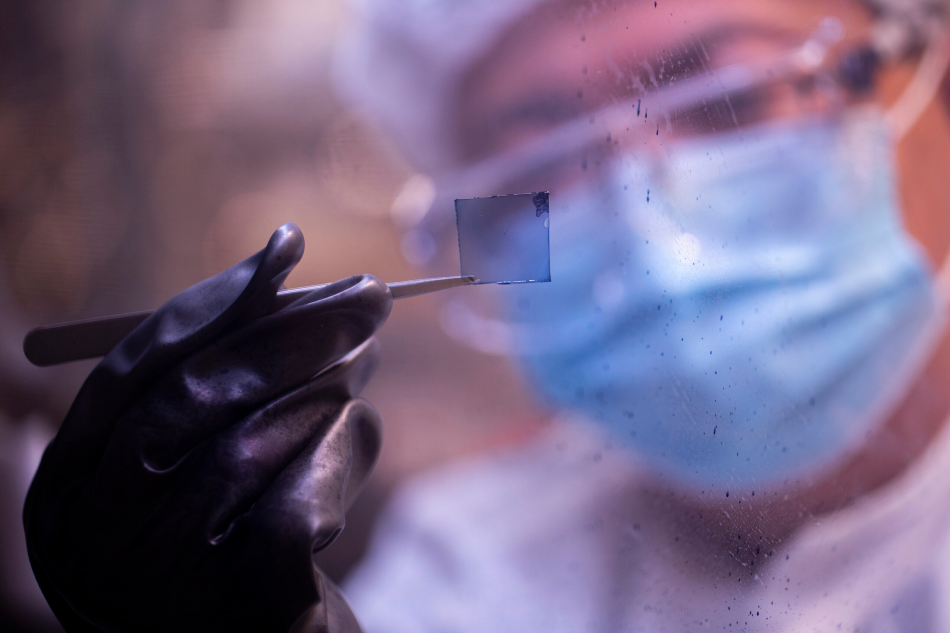Aug 18 2020
A team of researchers from the University of Michigan has set a new record for the efficiency of color-neutral, transparent solar cells. This achievement has led the team a step closer toward building skyscrapers that could be sources of power.
 Yongxi Li holds up a sample of a transparent solar cell. Image credit: Robert Coelius, Michigan Engineering Communications & Marketing.
Yongxi Li holds up a sample of a transparent solar cell. Image credit: Robert Coelius, Michigan Engineering Communications & Marketing.
The researchers realized a transparency of 43.3% and an efficiency of 8.1% with the help of an organic, or carbon-based, design in contrast to traditional silicon. Although the cells sport a somewhat green tint, they are quite similar to the gray of automobile windows and sunglasses.
Windows, which are on the face of every building, are an ideal location for organic solar cells because they offer something silicon can’t, which is a combination of very high efficiency and very high visible transparency.
Stephen Forrest, Peter A. Franken Distinguished University Professor of Engineering and Paul G. Goebel Professor of Engineering, University of Michigan
The new study was led by Forrest.
Buildings constructed with glass facades often have a coating that absorbs and reflects some of the light, both in the infrared and visible regions of the spectrum, to decrease the heating and brightness within the building.
Instead of wasting that energy, transparent solar panels could tap it to meet a part of the electricity needs of the building. Certain existing windows exhibit transparency similar to that of the solar cells described by Forrest in the Proceedings of the National Academy of Sciences.
The new material we developed, and the structure of the device we built, had to balance multiple trade-offs to provide good sunlight absorption, high voltage, high current, low resistance and color-neutral transparency all at the same time.
Yongxi Li, Assistant Research Scientist in Electrical Engineering and Computer Science, University of Michigan
The new material is a blend of organic molecules designed to be absorbing in the near-infrared region—an invisible area of the spectrum that makes up a considerable portion of the energy in sunlight—and transparent in the visible region.
Moreover, the team created new optical coatings to increase not only the power produced from infrared light but also the transparency in the visible range—two properties that often compete with each other.
An indium tin oxide electrode was used to make the color-neutral version of the device. The efficiency was enhanced to 10.8%, with a transparency of 45.8%, by using a silver electrode. But the slightly greenish tint of that version may not be acceptable in certain window applications.
Transparent solar cells are quantified by their efficiency to utilize light, which outlines the amount of energy that is available from the light hitting the window either as electricity or as transmitted light on the interior side.
Transparent solar cells developed earlier have light utilization efficiencies of approximately 2%–3%. However, the light utilization efficiency of the indium tin oxide cell is 3.5% and that of the silver version is 5%.
It is possible to manufacture both versions at a large scale by using materials that are less harmful compared to other transparent solar cells. Moreover, it is feasible to tailor the transparent organic solar cells for local latitudes, thereby leveraging the fact that they are most efficient when the rays from the sun hit them at a perpendicular angle. They can be positioned in between the panes of double-glazed windows.
Forrest and his colleagues are making efforts to achieve various enhancements to the technology, and their next aim is to achieve a light utilization efficiency of 7% and extending the service life of the cell to about 10 years. Moreover, they are analyzing the economics of setting up transparent solar cell windows into existing and new buildings.
The study has been described in the article titled “Color-Neutral, Semitransparent Organic Photovoltaics,” published in the Proceedings of the National Academy of Sciences by Forrest, Li and colleagues Xia Guo, Zhengxing Peng, Boning Qu, Hongping Yan, Harald Ade, and Maojie Zhang. The team includes researchers from North Carolina State University, Soochow University in China, and SLAC National Accelerator Laboratory.
This material has been developed based on the study supported by the U.S. Department of Energy Solar Energy Technologies Office as well as the Office of Naval Research and Universal Display Corporation.
Forrest is also a professor of electrical engineering and computer science, material science and engineering, and physics.
Journal Reference:
Li, Y., et al. (2020) Color-neutral, semitransparent organic photovoltaics for power window applications. Proceedings of the National Academy of Sciences. doi.org/10.1073/pnas.2007799117.